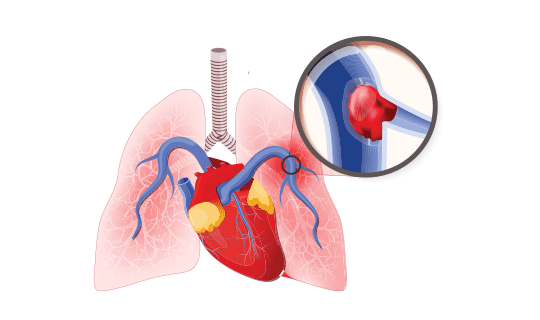Mechanically clearing arteries to the lungs can quickly reduce heart risks.
A 52-year-old woman came to Monmouth Medical Center Southern Campus (MMCSC) feeling chest pain and shortness of breath. But she wasn’t having a heart attack. Instead, she had a pulmonary embolism—a blockage of the large blood vessels called the pulmonary arteries that carry blood away from the heart to the lungs, often due to a blood clot.
She became a textbook case on the effectiveness of a new treatment called the FlowTriever Retrieval/Aspiration System, which can quickly resolve a pulmonary embolism and reduce the risks of side effects that may occur with traditional therapies.

“In some patients, symptoms of pulmonary embolism can be very severe and, if left alone, life-threatening,” says Philip Murillo, MD, a radiologist at MMCSC. “The main goal of treatment is to find out why the blood clots have formed and address the underlying problem.”
One priority is alleviating symptoms before they get worse. Often, this is done using blood thinners or stronger medicines called thrombolytics that break down blood clots. But sometimes, thrombolytics aren’t enough to address large clots. “If a large clot stays in place, the heart has to work extra hard to push blood to the lungs,” Dr. Murillo says. “This can strain the heart and may even cause it to stop working.”
Tests showed the woman’s heart was under strain. Her clot needed to be addressed right away.
Minimally Invasive Treatment
The FlowTriever system quickly removes even large clots in a procedure called a pulmonary thrombectomy. “This is done by navigating the FlowTriever catheter—a thin, flexible tube—through a large vein in the groin, up to the heart and into the pulmonary arteries,” Dr. Murillo says. “With the catheter in position, clots are removed by suction into a syringe.”
The treatment mechanically removes clots in a more immediate way than medication would, though medication may also be used. FlowTriever is the first and only mechanical thrombectomy system specifically for treating pulmonary embolisms.
The woman was brought to interventional radiology and received the FlowTriever procedure. Contrast dye injected after clot removal showed dramatically better flow through her pulmonary arteries. “The oxygen level in her blood greatly improved compared to before the procedure,” Dr. Murillo says.
FlowTriever treatment can almost immediately improve symptoms like shortness of breath and low blood pressure. It also spares patients large doses of thrombolytic medications given over a period of time, which may lengthen time spent in higher-level care such as an intensive care unit and can increase the risk of bleeding.
“Having this technology available at MMCSC is significant,” Dr. Murillo says. “It not only effectively treats the disease process before it progresses to a potentially life-threatening stage, but also may help limit the use of stronger thrombolytic medicines.”
To learn more about Monmouth Medical Center Southern Campus' Heart, Vascular and Thoracic Services, or make an appointment with a top cardiovascular specialist, call 888-724-7123.
